Review: Motorola Moto Z2 Play for Verizon Wireless
Jul 12, 2017, 7:30 AM by Eric M. Zeman
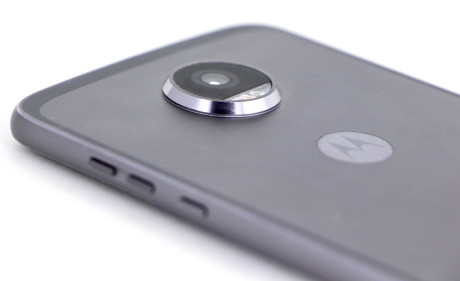

Moto Z2 Play
Motorola's latest Android smartphone is the mid-range and highly-capable Moto Z2 Play. This winsome handset may not stay strictly true to the original, but it is compatible with all of Motorola's Moto Mods accessories and still brings plenty to the table. Here is Phone Scoop's in-depth review of the Moto Z2 Play for Verizon Wireless.
Hardware
Is It Your Type?
The Moto Z2 Play is a mid-range handset that's compatible with Motorola's collection of Moto Mods accessories. The Z2 Play makes the most sense for those who may have already invested in several Mods, but it's also a good buy for just about anyone who needs a solid everyday performer.
Body
It would be easy to write off the Z2 Play as a minor spec bump to last year's excellent Z Play. Thankfully, there's a lot to like about this second-generation, affordable smartphone from Motorola.
For example, the Z2 Play's design is better than the original. As much as I liked the metal-and-glass chassis of last year's Z Play, the twin glass panels left the original more exposed to breakage. This year's phone drops the fragile glass rear panel in favor of an attractive metal plate. I dig it.
Motorola picked 2.5D glass for the front of the Z2 Play, though the curved edge is somewhat buried in the frame. The aluminum frame wraps all the way around the phone and has attractive chamfers along the edges that give it a little extra pizzazz. I like the gray-on-gray coloring of our review unit, though Verizon also sells the Z2 Play in gold. (Motorola will sell the Z2 Play in more colors later this summer.) The gray paint on the frame has a nice visual texture to it. The Z2 Play is a good looking phone and it comes across as stronger and less delicate than the original.
The Z2 Play is slightly smaller and lighter than the Z Play. Keep in mind, the Moto Mods accessories demand a certain footprint, and all the Mods-compatible phones share similar (big) dimensions. (Motorola sort of designed itself into a corner here.) Even so, Motorola trimmed the fat lining the Z Play's waistline, giving the Z2 Play a slimmer 6mm chassis. At the same time, the frame takes on a deeper curved shape that works with the thinner profile to make the Z2 Play more comfortable to hold and use.
We can't pretend the Z2 Play is small — many people will still need two hands to interact with it — but there's no doubt in my mind that it's a more usable handset than the original. I appreciate the Z2 Play's drop in weight (from 5.82 ounces to 5.11 ounces), but the weight loss won't matter much if you snap a battery pack or other heavy Mod onto the back. The phone is slim enough that it slips into pockets with ease.
The materials and build quality are excellent. It's so close in quality to the Z Droid that you could easily mistake the Z2 Play for Motorola's flagship. I'm impressed by the rigidity of the frame and how tightly all the pieces are assembled. Nothing about the phone feels cheap or flimsy. The glass, metal, and polycarbonate components all fit together cleanly and with precision.
The Z2 Play's face doesn't deviate from the Motorola playbook much. The black glass fills out the front nicely. You'll easily spot the two-tone LED selfie flash in the top-left corner. The user-facing camera is hard to spot, while the "moto" logo (yes, lowercase "m") is painted on between the earpiece and the top edge of the display. I wish the display were as black as the thick bezels surrounding it, but it's not. Perhaps the biggest improvement in design rests on the phone's chin: the Z2 Play has a nice, oval-shaped fingerprint reader that's easy to find and use. It's far more usable than the small square reader on last year's phone. The actual nav cluster comes and goes as needed on the screen itself.
Similar to the Moto E4, the Z2 Play's fingerprint reader doubles as a navigation tool. You'll need to turn to on the features using the Moto App. Once you do, the fingerprint reader acts like a trackpad and allows you to navigate back or access the app switcher when you swipe left or right, respectively. Of note, if you turn on the fingerprint reader navigation controls, the screen-based buttons go away.
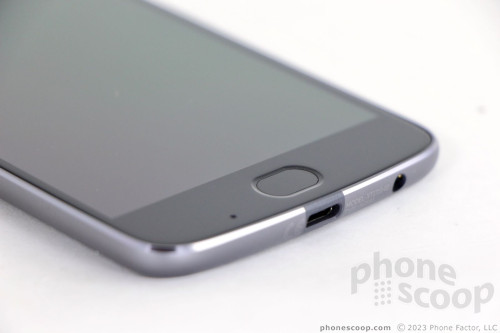
A trio of buttons are perched high on the right edge of the phone. The lowest of the three is the screen lock key. It has a ridged texture to help it stand apart from the other two buttons. I'd call the button a little small, but the travel and feedback are very good. The volume controls are separated into two flat buttons above the screen lock key. Motorola put a significant gap between the two, which helps your thumb effortlessly differentiate between them. These buttons also have good travel and feedback.
The SIM / memory card combo tray is tucked into the top edge of the phone. It's easy to interact with using the proper tool. The USB-C port and 3.5mm headset jack are both found on the bottom edge of the phone.
Like other Moto Mod-capable phones, the Z2 Play's rear panel is a busy place. A dark gray band of polycarbonate joins the flat metal plate to the frame. The difference in color between the plate and the band helps give the phone some personality. You can't miss the absolutely huge camera module near the top. It's about the size and shape of a quarter with a nickel stacked on top. It's significant. The two-tone flash and lens opening are plainly visible within the module, both protected by a circular piece of glass. Motorola's modular accessories fit around the camera with no problem, and actually rely on it as an anchor of sorts. The Motorola logo is set in a plastic, mirror-like insert that fits into a hole cut into the rear plate. (This design choice is probably to accommodate an antenna, perhaps for NFC.)
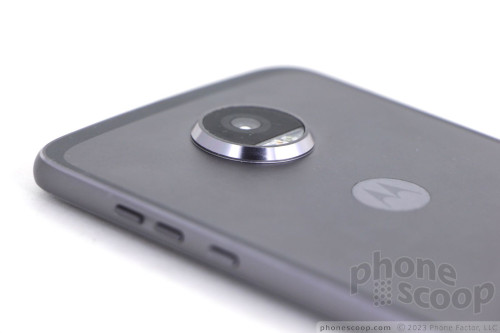
Motorola's proprietary magnetic module connector is positioned near the bottom of the rear panel. The magnets feel incredibly strong and robust, though it is still easy to pry Mods off when you want to. I've used Moto's Z-branded handsets on and off for close to a year and never had a Mod fall off. Mods fit on the Z2 Play perfectly and securely.
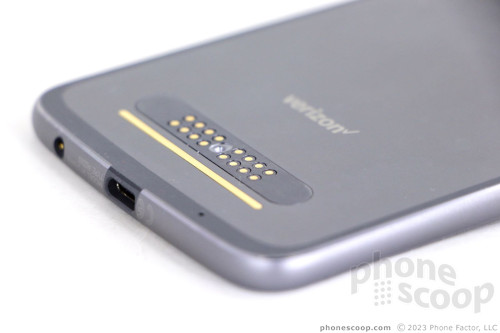
The rear panel is sealed up tight, so swapping the battery is not going to happen. Motorola has dedicated battery Mods for those who get angsty about battery life.
Perhaps my only legit gripe about the Moto Z2 Play is its lack of real waterproofing. Motorola coated the interior electronics with a water resistant material. It can handle light rain and perhaps some splashing, but the Z2 Play cannot handle immersion, such as dunks in backyard pools.
That said, Motorola has done an excellent job updating its mid-range offering. The Z2 Play is a near-flagship quality handset that impresses all the way around.
Screen
The Z2 Play may have a sharp new chassis, but the screen is a direct carryover from last year's handset. That means the phone has a 5.5-inch full HD AMOLED panel with a pixel density of 401ppi.
The pixels are packed in tightly enough that spotting them along the edges of text, graphics, and images is nigh impossible. AMOLED displays are great when it comes to contrast. Colors are perhaps oversaturated a bit, but I think as a whole the Z2 Play's brightness, color, and contrast are very good. I was able to see the screen when outdoors under sunny skies with no problem. Viewing angles are excellent. The display looks great for this class of handset.
Signal
Motorola knows how to make phones that connect to Verizon's network. The Z2 Play was a signal champ throughout my time with it. I was able to connect calls on the first dial in strong and weak coverage areas alike, and calls didn't drop even when traveling at highway speeds. I did see one call that went straight to voicemail. Data speeds were very good. The Z2 Play supports Cat. 6 LTE (as opposed to the Z Play's Cat. 4). In the real world, that means the phone was able to keep me up-to-date on Twitter and Instagram while streaming Spotify. I didn't run into any buffering or other oddities when watching YouTube videos over 4G. The Z2 Play is a good cell phone.
(The unlocked model will support AT&T/T-Mobile 4G when it goes on sale later this summer.)
Sound
The earpiece does double duty: it handles regular calls and speakerphone calls. This is a design characteristic common to Motorola's recent handsets. The Z2 Play is an excellent voice phone when you use the phone normally (i.e., hold it to your ear). Clls via the earpiece are crazy clear. It's so clean, warm, and friendly. Volume is quite good and the Z2 Play allows you to hold conversations in noisy environments, such as busy shopping centers and bustling coffee shops. I had no trouble hearing people in a moving car. Those I spoke to through the Z2 Play said I sounded "great".
I was hoping for more from the speakerphone. It loses both clarity and volume when compared to the earpiece in normal mode. Calls come through a bit muffled and I had a hard time hearing calls in the car even when the volume was cranked all the way up. In this respect the inexpensive Moto E4 actually outperforms the Z2 Play a bit, as the E4 exhibited clearer, louder speakerphone calls. You can use the Z2 Play for speakerphone calls in quiet spaces, but you'll have trouble with it in louder spaces.
The ringers and alerts could be louder. I missed some calls because I didn't hear the ringtone. I was pleased with the vibrate alert, which was strong enough to get my attention.
Battery
The Z2 Play is thinner than the Z Play because Motorola raided the battery. Last year's phone boasted an impressive 3,510 mAh power supply that easily lasted through two full days of hard use. This year's phone trims 14% of that capacity down to an even 3,000 mAh.
Don't fret too much. I consistently got about one and a half days from the Z2 Play. That's easily more than most phones on the market, even if it's not quite as much as the two days of battery offered by last year's Z Play. I think the majority of people will be pleased with battery life.
The basic Android battery saver tool is the only power management software installed. You can toggle it on manually or set it to flip on automatically. It helps a little bit.
Motorola made sure the Z2 Play supports its TurboPower charger and it ships one in the box. The phone was able to jump from 50% capacity to 85% capacity in less than 25 minutes when plugged in. That's hours and hours of uptime. If you find yourself in battery trouble, a quick recharge goes a long way.
Sorry folks, no wireless charging.
Bluetooth, GPS, NFC, WiFi
The Z2 Play's Bluetooth radio mostly worked well. The phone paired and connected with accessories such as headphones and speakers with no trouble. The same goes for nearby computers.
I saw a few hiccups when I tried pairing the Z2 Play with my car's hands-free system. After I made the connection, call quality through my car was pretty rough.
Calls sounded better when sent to a regular Bluetooth headset. Music sounded very good through my current favorite Bluetooth headphones.
As for GPS, the Z2 Play performed on par with the best. It plotted my location in 1 or 2 seconds and was accurate to within 15 feet. The phone handled real-time navigation between points perfectly.
The NFC radio gave me some trouble. I wasn't able to use it to pair with other NFC-equipped devices, such as headsets. That's a definite bummer. The NFC radio does support Android Pay for mobile payments and it worked well when I wanted to transfer settings between phones.
I didn't experience any issues with the WiFi radio.
Software
Editor's Note: The Moto Z2 Play runs identical software to the Moto E4, which Phone Scoop recently reviewed. Some portions of the following text have been carried over from that earlier review. Rest assured, we thoroughly tested every facet and feature of the Moto Z2 Play and updated everything unique to the Z2 Play below.
Lock Screen
The Moto App now handles the ambient display on Motorola handsets and manages the lock screen and notifications.
The Moto Display function in the Moto App can wake the screen regularly with a list of the current notifications; show important notifications on the lock screen as they arrive; or leave the screen entirely dark. The behaviors are fully customizable, which is something I've long appreciated about Motorola smartphones.
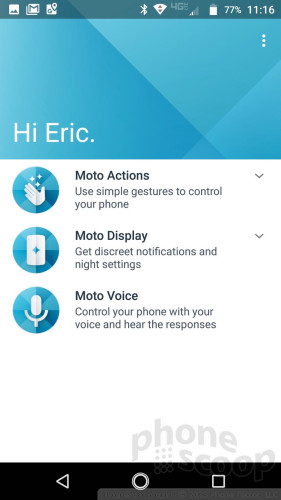
Unlike the E4, the Z2 Play screen will wake when you double-tap the glass. It also adds a touch-and-hold feature to lock screen notifications so you can glean a bit more info, such as email sender and subject line.
If you press the screen lock button, the display wakes fully to show the clock, wallpaper, and notifications listed below the clock. There are also shortcuts to the Google Assistant and camera on this screen. Sadly, you can't customize the shortcuts. (But hey, Google Assistant!)
The Z2 Play's fingerprint reader performed very, very well. I like the feel of the indented oval much better than that of the slightly raised square on last year's phone. It was quick to record fingerprints and consistent at recognizing fingerprints on the first try. When you're done using the phone, press the fingerprint reader to automatically put the display to sleep and lock the phone.
Home Screens
The Z2 Play ships with Android 7 Nougat with minimal tweaks from Motorola. Owners can customize the typical stuff, such as wallpapers, widgets, and so on. The home screens behave as expected for an Android Nougat phone.
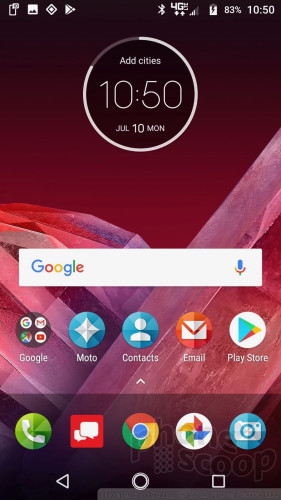
The app drawer is almost standard Android. It doesn't include a dedicated button on the home screen. Instead, you swipe up from the dock to bring up the app drawer, similar to Pixel phones. Apps are listed alphabetically in the drawer, with four app suggestions lining the top. The Z2 Play trades the white background found on Pixel app drawer for whatever wallpaper you have set for the home screen. The app drawer doesn't support folders, nor does it allow you to hide apps.
The notification shade, Quick Settings tool, and main settings screens are all standard Android, and work accordingly. There are no themes or other fancy interface tricks on board, which is fine as far as I am concerned.
As noted earlier, the fingerprint sensor doubles as a navigation pad and it is managed via the Moto App. You have to turn it on manually. It works well enough when I remembered to use it. Turning it on eliminates the on-screen nav controls.
There are plenty of Verizon-branded apps aboard, and a whole folder of Verizon stuff on the home screen.
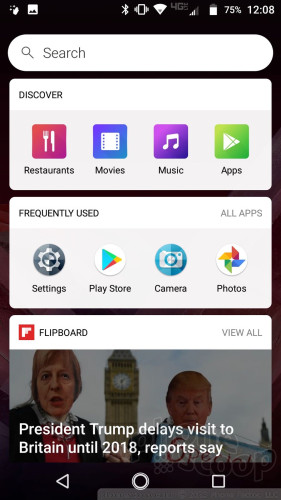
The one real annoyance is an app called AppFlash. Verizon announced plans to add this app to its phones just a few months ago and this is the first time I've seen it on a handset. This app sort of acts like Google Now in that it takes over the left-most home screen panel. It includes a search bar at the top, followed by a handful of cards. The top card lists four suggested search topics (restaurants, movies, music, apps) and the second card lists your frequently used apps. This is followed by a card from Flipboard with news headlines and yet another card with more suggested apps. It's important to note that AppFlash scans your device for apps and reports back to Verizon what you've installed. It does this to better target you with ads. You can, thankfully, disable AppFlash and prevent it from spying on you.
With respect to performance, the Moto Z2 Play has a 2.2 GHz Snapdragon 626 processor with 3 GB of RAM and 32 GB of storage. The 626 chip delivered consistent performance across the board on our review unit. The phone ran really well.
Camera
The Z2 Play does not have a dedicated physical camera button, but there are several ways to open the camera. The good-old wrist-twisting gesture that Motorola has included on its phone for years is still my favorite way to open the camera. Alternately, you can use the lock screen shortcut or home screen icon. The app opens swiftly.

There are three controls on the left side of the screen (timer, flash, HDR) and three on the right (mode, shutter, front camera). I like that both the flash and HDR tools can be set to on, off, or auto.
As for shooting modes, the Z2 Play offers auto, video, slo-mo, panorama, and manual. The manual mode lets you take full control over focus, ISO, shutter speed, brightness, and white balance. The controls line the top of the screen and are easy to adjust. It's a shame the shutter only lets you select speeds as slow as one-third of a second; that's hardly long enough to get creative or take really great night shots. There's no time-lapse mode, nor is there any sort of GIF maker.
The default is always auto mode. Slide your finger up or down to zoom. Tap to focus and set exposure. Press the shutter button to take standard pictures, or press-and-hold to capture a burst. Swipe from the left side of the screen to access more minor settings such as grid-lines and resolution.
The layout is easy enough for novices to use effectively, and flexible enough in manual mode to unleash at least some degree of creativity. The Z2 Play's processor and RAM combo ensure quick performance of the camera, which ran fluidly while I reviewed it.
Photos/Video
The Z2 Play has a 12-megapixel sensor with an aperture of f/1.7 to let in as much light as possible. It uses both laser autofocus and phase detection autofocus (PDAF) to dial in sharp photos.
I was generally impressed with the pictures I took with the phone. The majority of shots showed excellent focus, good exposure, and proper white balance. I saw a few instances of slight over-exposure (see the balloon's colors, and my white t-shirt), however, in both these instances there were dark backgrounds making things difficult. Considering the amount of detail visible in those backgrounds, the little bit of extra exposure works. Bottom line: the Z2 Play has a fine camera.
The front-facing camera has a 5-megapixel sensor and an f/2.2 wide-angle lens. The fact that the Z2 Play has a two-tone LED flash on the front is quite something. Finding a selfie flash on a phone is rare enough, but the two-tone LED means your Snapchat and Instagram selfies will look even better. The selfie cam does a fine, fine job and manages to balance exposure, focus, and white balance well. If you're not happy with how you look, you can always use the beautification tool to erase those imperfections.
As for video, the main camera shoots footage up to 4K and the selfie cam can snag 1080p. The 4K stuff looks great, if you have a monitor capable of displaying it, but I think most people can stick with 1080p when shooting video. The samples I captured with the Z2 Play were clean, sharp, and colorful.
You can certainly rely on the Z2 Play as your everyday shooter and it may even serve on vacations and other events.
Moto Voice
The Moto App contains a third tool (not available on the E4) called Moto Voice. The tool sort of mimics Google Now in that you blurt out voice commands and the Z2 Play obliges. It takes several minutes to walk through the tutorial. Rather than say "Hey Google" or "OK Google" you simply say "Show me my…" to see your calendar, your call log, and so on. It works pretty well for opening apps and seeing basic personal info, but can't complete more complex actions such as compose a message. It will react when the phone is locked.
Honestly, just use Google Assistant, which is on board and fully functional.
Moto Mods
Just a quick word on Moto Mods: The Z2 Play is of course compatible with the existing and new Mods from Motorola. We have several of the latest on hand and are testing them separately. The Z2 Play interacts with Moto Mods perfectly and we look forward to sharing our thoughts on the JBL SoundBoost 2, TurboPower Pack, and Style Shell Mods soon.
Wrap-Up
Motorola did a bang-up job with this phone. Almost every aspect of the hardware and software impresses and performs above the Z2 Play's affordable price point.
Motorola gave the Z2 Play a strong metal chassis that's fully compatible with its roster of Moto Mods accessories. The phone's thin profile and bright screen are attractive, the signal and voice performance are ideal, and the battery life is above average. I did see some weirdness with the Bluetooth and NFC, but these are hardly deal-breakers.
Android 7.1 Nougat is a great platform and additions such as the Moto App — with the active display, gesture tools, and Moto Voice — improve usability across the board. I seriously question Verizon's use of the AppFlash software, though it can be disabled (if not uninstalled.) The camera app is a little basic, but the excellent images more than make up for it.
Verizon is selling the Motorola Moto Z2 Play for $408 and that's a bargain. This phone punches way above its mid-range status. It's a better buy than the OnePlus 5, and an excellent phone for all but the most finicky flagship seekers. Go buy this phone now.

Comments
No messages


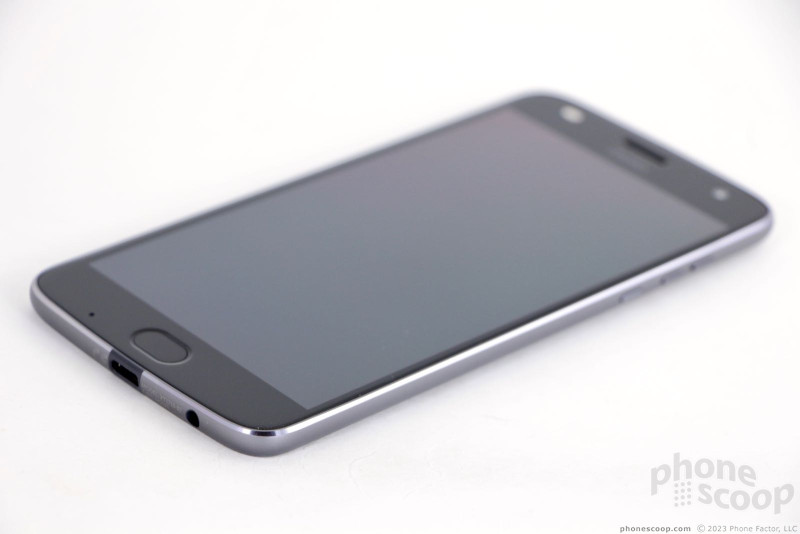





















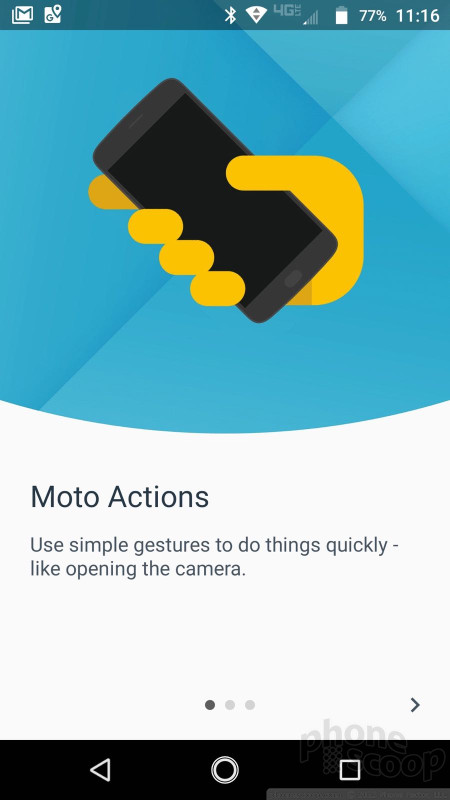





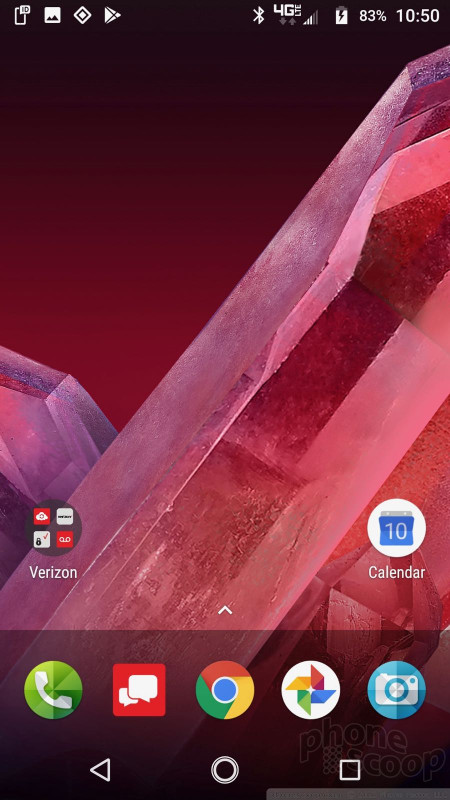





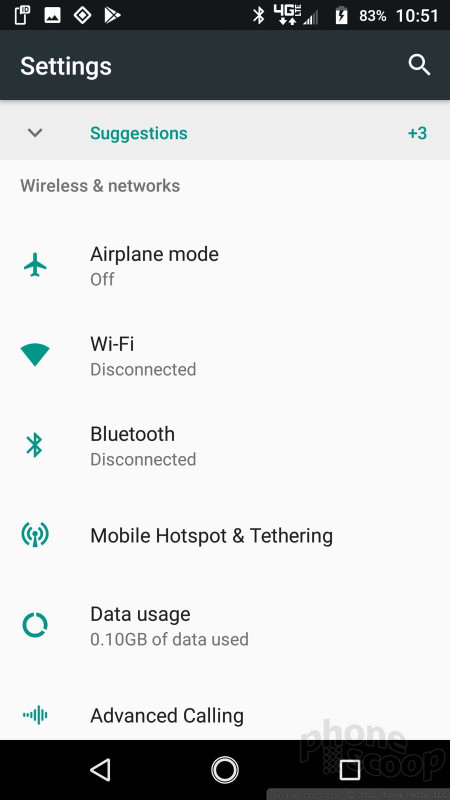






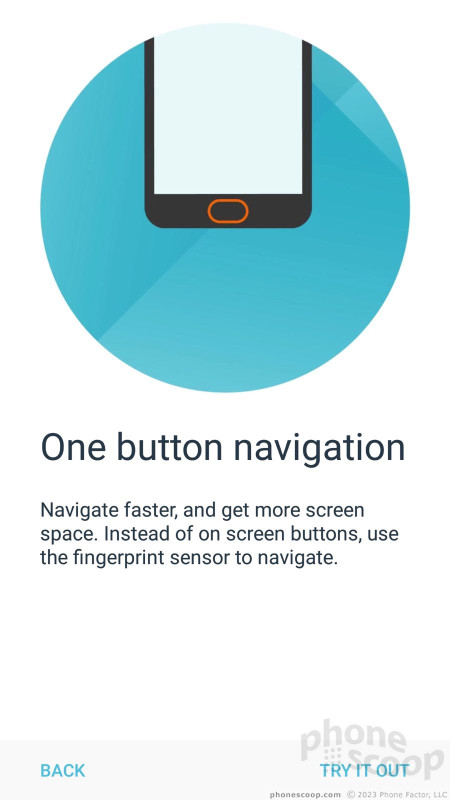





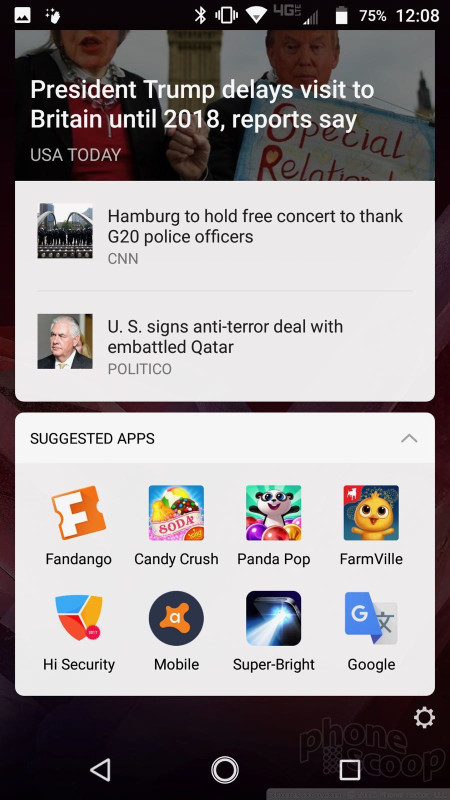





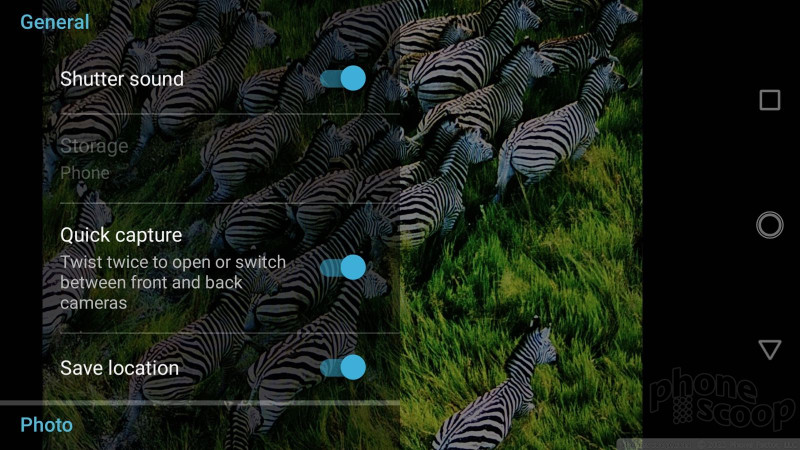




















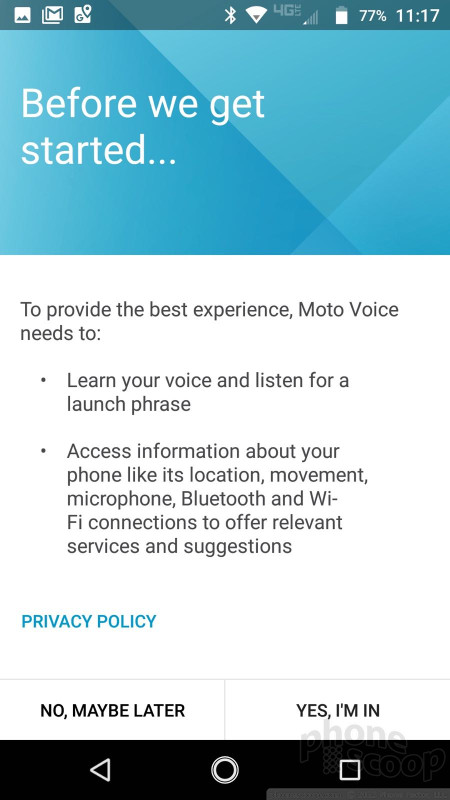













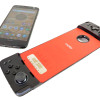 Review: Motorola Moto Gamepad for Moto Z2 Force
Review: Motorola Moto Gamepad for Moto Z2 Force
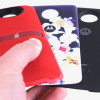 Review: Moto Mods for Motorola Z2 Play
Review: Moto Mods for Motorola Z2 Play
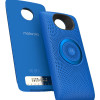 Motorola Kicks Out Fresh Stereo Speaker Mod for Moto Z Phones
Motorola Kicks Out Fresh Stereo Speaker Mod for Moto Z Phones
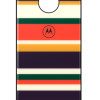 Motorola Debuts 5 Gorilla Glass Mods for Moto Z Phones
Motorola Debuts 5 Gorilla Glass Mods for Moto Z Phones
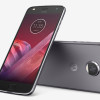 Motorola Rolls Out Savings On Smartphones And Mods
Motorola Rolls Out Savings On Smartphones And Mods
 Motorola Moto Z2 Play
Motorola Moto Z2 Play











